图形用户界面(GUI)详细发展历史
-
History of the graphical user interface
Thegraphical user interface, or "GUI", is a computer interface that uses graphic icons and controls in addition to text. The user of the computer utilizes a pointing device, like a mouse, to manipulate these icons and controls. This was a great leap forward from the command line interface used in other operating systems, in which the user types a series of text commands to the computer.
Initial Developments
The first concept of a windowing system begins with the first real-time graphic display systems for computers, namely the SAGE Project and Ivan Sutherland’s Sketchpad.
Augmentation of Human Intellect
Doug Engelbart’s Augmentation of Human Intellect project at SRI in the 1960s developed the On-Line System, which incorporated a mouse-driven cursor and multiple windows.
Xerox PARC
Engelbart’s work directly led to the advances at Xerox PARC. Several people went from SRI to Xerox PARC in the early 1970’s. The Xerox PARC team codified the WIMP (windows, icons, menus and pointers/pull-down menus) paradigm, first pioneered on the Xerox Alto experimental computer, but which eventually appeared commercially in the Xerox 8010 (’Star’) system in 1981.
Apple Lisa and Macintosh
Beginning in 1979, led by Jef Raskin, the Lisa and Macintosh teams at Apple Computer (which included former members of the Xerox PARC group) continued to develop such ideas. The Macintosh, released in 1984, was the first commercially successful product to use a GUI. A desktop metaphor was used, in which files looked like pieces of paper; directories looked like file folders; there were a set of desk accessories like a calculator, notepad, and alarm clock that the user could place around the screen as desired; and the user could delete files and folders by dragging them to a trash can on the screen.
There is still some controversy over the amount of influence that Xerox’s PARC work, as opposed to previous academic research, had on the GUIs of Apple’s Lisa and Macintosh, but it is clear that the influence was extensive.
The Macintosh’s GUI has been revised with time since 1984, with a major update with System 7, and underwent its largest revision with the introduction of the "Aqua" interface in 2001’s Mac OS X.
VisiOn
Graphical user interface primarily designed for spreadsheets by the company that wrote the legendary VisiCalc spreadsheet. First introduced the "windows" concept and a mouse to the PC environment, in 1983. Preceded the first Microsoft Windows implementations. VisiOn never took off because it could not be used to run other MS-DOS applications and was buggy and expensive. Inspired the multitasking system DESQview.
Amiga Intuition
Amiga computers developed a GUI in 1985 called Intuition. In this GUI directories were shown as filing cabinet drawers.
The Amiga GUI was unique for its time because it featured a pop-up command line interface (CLI) for those times when a GUI does not offer enough control.
GEM
At the time Microsoft was developing Windows in the 1980s, Digital Research developed the GEM Desktop GUI system. GEM was created as an alternative window system to run on IBM PC systems, either on top of MS-DOS (like Microsoft Windows) or on top of CPM-86, DR’s own operating system that MS-DOS was patterened after. GEM achieved minimal success in the PC world, but was later used as the native GUI on the Atari ST machines.
GEOS
GEOS was another very early graphical desktop system. Originally written for the 8 bit home computer Commodore 64 it was later ported to IBM PC systems. It came with several application programs like a calendar and word processor, and a cut-down version served as the basis for America Online’s DOS client. Compared to the competing Windows 3.0 GUI, it could run reasonably well on simpler hardware.
Revivals were seen in the HP OmniGo handhelds, Brother GeoBook line of laptop-appliances, and the New Deal Office package for PCs. Related code found its way to earlier ’Zoomer’ PDAs, creating an unclear lineage to Palm, Inc’s later work.
Microsoft Windows
Microsoft modeled the first version of Windows, released in 1985, on the GUI of the Mac OS. Windows 1.0 was a GUI (graphic user interface) for the MS-DOS operating system that had been the standard OS for with IBM PC and compatible computers since 1981. Windows 2.0 followed, then in 1990 the Windows 3.0 launch was when the popularity of Windows really exploded. The GUIs of subsequent versions of Windows have been similar to the GUI of Windows 3.0.
In 1988, Apple sued Microsoft for copyright infringement of the Lisa and Apple Macintosh GUI. The court case lasted 4 years before almost all of Apple’s claims were denied. Subsequent appeals by Apple were also denied, and Microsoft and Apple apparently entered a final, private settlement of the matter in 1997 as a side note in a broader announcement of investment and cooperation.
RISC OS
Early versions of what became called RISC OS were known as Arthur, which was released in 1987. RISC OS was a colour GUI operating system which used three-buttoned mice, a taskbar (called the iconbar), and a file navigator similar to that of Mac OS. Acorn created RISC OS in the 1980s for their ARM-CPU based computers.
NeXTSTEP
The NeXTSTEP user interface was used in the NeXT line of computers. NeXTSTEP’s first major version was released in 1989. It used Display PostScript for its graphical underpinning. The NeXTSTEP interface’s most significant feature was the Dock, carried into Mac OS X, and had other minor interface details that some found made it easier and more intuitive to use than previous GUIs. NeXTSTEP’s GUI was the first to feature opaque dragging of windows in its user interface, on a comparatively weak machine by today’s standards.
/H3> Originally collaboratively developed by Microsoft and IBM to replace DOS, version 1.0 (released in 1987) had no GUI at all. Version 1.1 (released 1988) included Presentation Manager (PM), which looked a lot like the later Windows 3.0 UI. After the split with Microsoft, IBM developed the Workplace Shell (WPS) for version 2.0 (released in 1992), a quite radical, object-oriented approach to GUIs. Microsoft later imitated much of this in Windows 95.
BeOSX Window System
The PostScript-based NeWS (Network extensible Window System) was developed by Sun Microsystems. For several years SunOS included a window system combining NeWS and the X Window System. Although NeWS was considered technically elegant by some commentators, Sun eventually dropped the product. Unlike X, NeWS was always proprietary software.
The X Window System
The standard windowing system in the Unix world, developed in the early 1980s, is the X Window System, or X. X was developed at MIT as Project Athena. Its original purpose was to allow users of the newly emerging graphic terminals to access remote graphics workstations, without regard to the workstation’s operating system or the hardware. Due largely to the availability of the source code used to write X, it has become the standard layer for management of graphical and input/output devices and for the building of both local and remote graphical interfaces on virtually all systems, including UNIX, the BSD operating systems and the GNU/Linux distributions.
X allows a graphical terminal user to make use of remote resources on the network as if they were all located locally to the user by running a single module of software called the X server. The software running on the remote workstation is called the client application. X’s network transparency protocols allow the display and input portions of any application to be separated from the remainder of the application and ’served up’ to any of a large number of remote users.
In the early days of X Window development Sun Microsystems and AT&T attempted to push for a GUI standard called OpenLook in competition with Motif. OpenLook was a well-designed standard developed from scratch while MOTIF was a collective effort that fell into place. Many who worked on OpenLook at the time appreciate its design coherence. Motif prevailed the ’religious’ war and became the bases for CDE (Common Desktop Environment). Both X and Open Motif are available today as free software.
In the late 1990s, there was significant growth in the Unix world, especially among the free software community. New graphical desktop movements grew up around GNU/Linux and similar operating systems, based on the X. A new emphasis on providing an integrated and uniform interface to the user brought about new desktop environments, KDE and GNOME.
See also:Apple v. Microsoft
Bill Atkinson
Doug Engelbart’s On-Line System
Graphical user interface
History of computing
History of Microsoft Windows
Ivan Sutherland’s Sketchpad
Jef Raskin
External links:
VisiOn history - The first GUI for the PC
以下来自:http://toastytech.com/guis/guitimeline2.html
1973

April 1973, the first operational Alto computer is completed at Xerox PARC.
The Alto is the first system to pull together all of the elements of the modern Graphical User Interface.
Features:
3-button mouse.
Bit-mapped display.
The use of graphical windows.
Ethernet network.
1980

1980: Three Rivers Computer Corporation introduces the the Perq graphical workstation.
1981
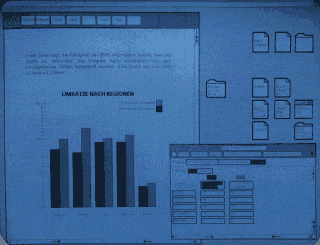
1981 June: Xerox introduces the Star, the commercial successor to the Alto.
Notable features:
Double-clickable icons, overlapping windows, dialog boxes and a 1024*768 monochrome display.
1983
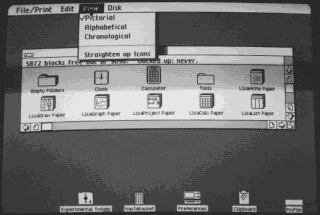
1983 January: Apple introduces the Lisa.
Notable features:
Pull down menus and menu bars.
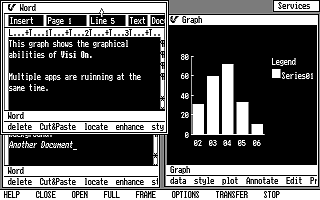
Visi Corp releases Visi On, the first integrated graphical software environment for IBM PCs. 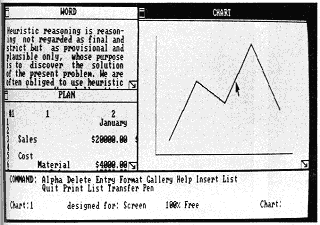
Microsoft announces their new "Windows" program for the IBM PC but does not release it until 1985.
Notable features:
Is supposed to have overlapping / resizable windows.
1984
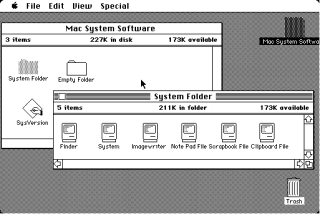
January 1984: Apple introduces the Macintosh. 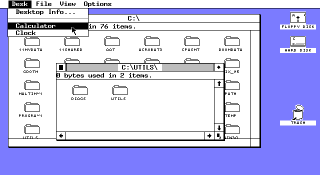
September: Digital Research announces its GEM icon/desktop user interface for 8086- and DOS-based computers. It also was later ported to the Atari ST.
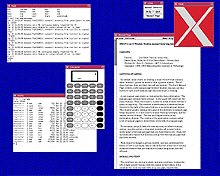
June: "window system X" announced at MIT.
Versions 1-6 were monochrome only, and ran on DEC VS100’s displays connected to VAXen and VAXstations 1 and 2.
Versions 8-10 dealt with color, for the VAXstation II/GPX. X10 is the first version that saw widespread availability and use on many vendor’s systems.
Version 11 was redesign for higher performance, more window management styles, extensibility and better graphics capability1985
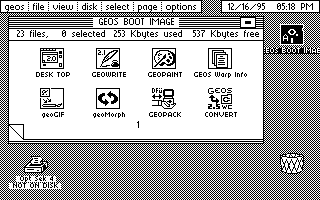
1985: Geos released for Commodore 64 and later the Apple II. 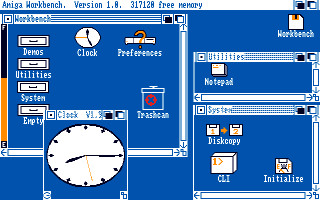
July: Commodore introduces the Amiga 1000 with the Amiga Workbench Version 1.0. 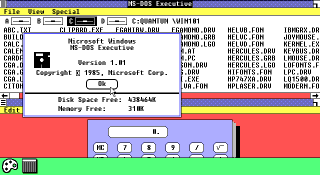
August: Microsoft finally releases the first version of Windows.
Features:
Windows can not be overlapped, but are instead "tiled".
Windows are not allowed to cover an area at the bottom of the screen that is reserved for "iconized" programs.
1986
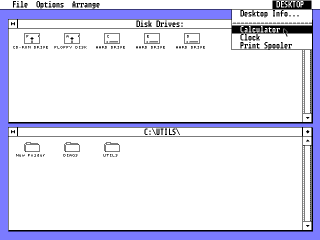
1986: Apple threatens to sue Digital Research because the GEM desktop looked too much like Apple’s Macintosh. Digital Research cripples the desktop application so Apple will not sue.
The new GEM desktop now has just two unmovable, non-resizable windows for file browsing.
1987
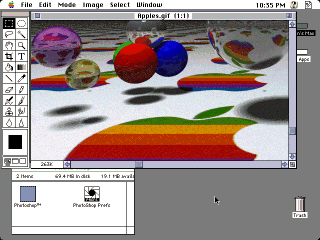
March 1987 - Apple introduces the Apple Macintosh II, the first color Macintosh.
Features: 640*480*256 color with 24 bit color card available.
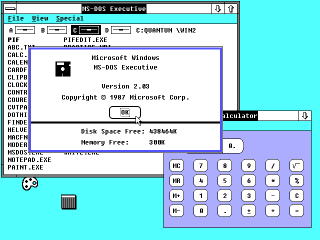
Microsoft releases the second version of Windows, version 2.03.
Features:
Finally has resizable / overlapping windows and new windowing controls.
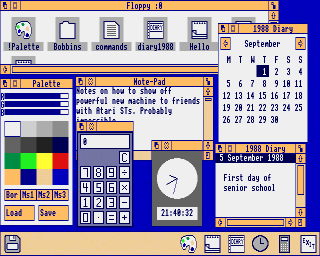
Acorn releases "Arthur" for the Acorn computer, it is the basis for RISC OS. RISC OS 2 and 3 have a similar look, but an improved feel.
1988

September 1988: Apple releases GS/OS, a 16-bit operating system with a Macintosh-like GUI for the Apple IIGS.
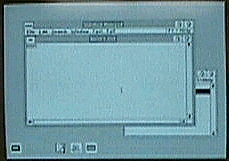
October: IBM releases OS/2 1.10 Standard Edition (SE) which added a graphical user interface called Presentation Manager. (OS/2 1.0 was text mode only!) The 1.10 GUI was written by Microsoft and looked like Windows 2.
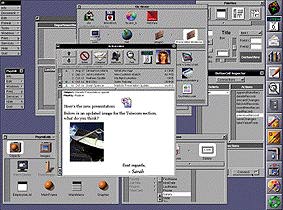
October: The NeXT Computer is released for $6500. It includes a 25 MHz ’30 processor, 8 MB RAM, 250 MB optical disk drive, math coprocessor, digital processor for real time sound, fax modem, and a 17" monitor. 1990
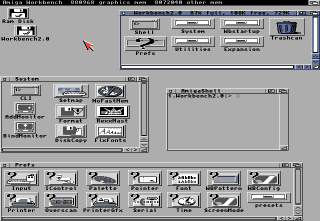
1990: Commodore releases Amiga Workbench 2 for the A3000.
Features: New 3d effects, a revised menu system and many other improvements.
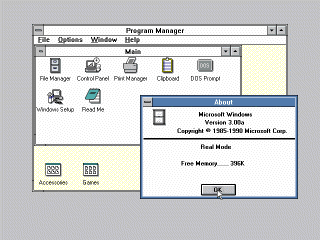
May 1990: Windows 3.0 released by Microsoft
Features: Program Manager shell.
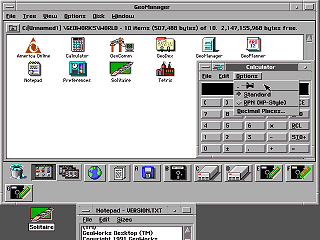
November: PC-GEOS released by GeoWorks.
1992
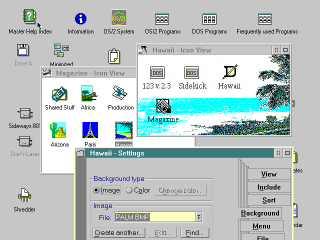
Spring of 1992: IBM releases OS/2 Version 2.0, a true 32-bit OS.
Features a new "Workplace Shell", an object oriented user interface that is heavily integrated with the rest of the OS.
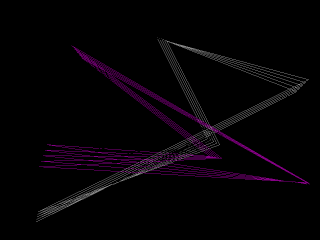
March: Microsoft introduces Windows 3.1. The user interface is basically the as Windows 3.0 but now includes their "multimedia" enhancements. 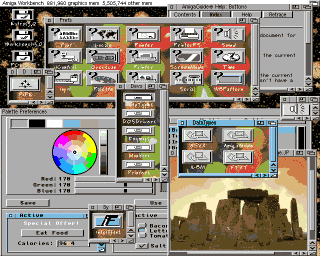
September: Amiga Workbench 3 released for AGA Amigas.
Features: Images for backgrounds, color pallet remapping.
1993
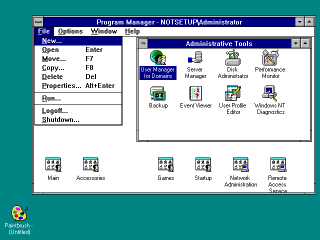
May 1993 Microsoft releases the first version of Windows NT, their 32-bit OS. They give it the version number "3.1" and use the user interface they do for regular Windows 3.1. Made available for Intel, Power PC, Alpha, and MIPS systems.
1994
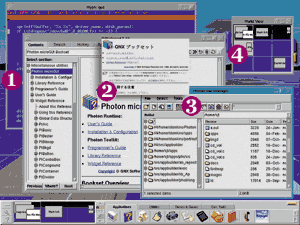
1994: QNX Software Systems releases the first embeddable microkernel windowing system, the Photon microGUI.
1995
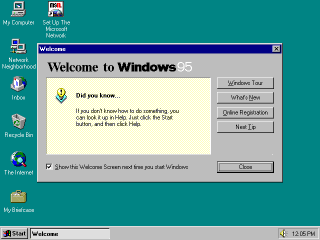
1995: Microsoft introduces Windows 95 on August 24th. 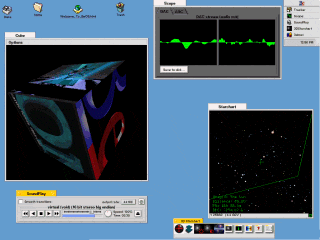
October: Be introduced BeOS at Agenda 96. The first version was designed to run on a custom multiprocessor system known as the "BeBox". Later made
1996
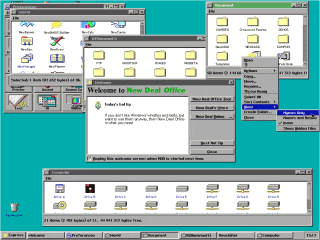
1996: New Deal releases New Deal Office 2.5, which was formerly PC-GEOS. 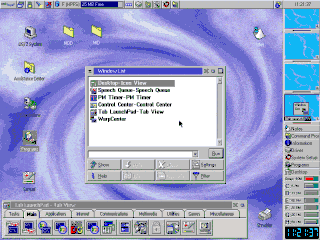
IBM Releases OS/2 Warp 4 with a significant facelift for the Workplace Shell. 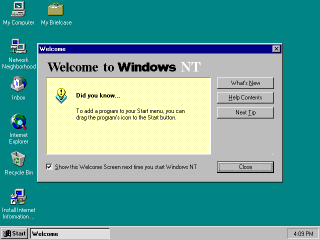
Microsoft releases Windows NT 4.0 with the user interface as Windows 95.
1997
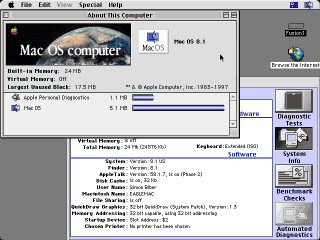
July 1997: Mac OS 8 is finally released. Selling 1.25 million copies in less than 2 weeks, it becomes the best-selling software in that period.
1998
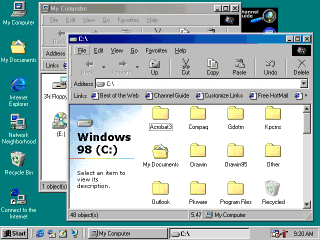
June 25, 1998: Microsoft releases Windows 98.
Features: Internet Explorer Web browser application takes over the role of the Windows shell, advertising right on the desktop, entire help system replaced by Internet Explorer.
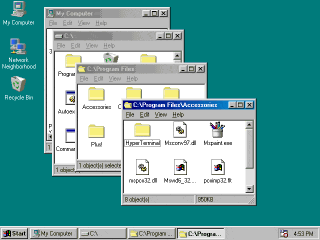
November 22, 1998: Shane Brooks Releases 98Lite, an installer that removes or prevents the installation of Internet Explorer with Windows 98.
Features No Internet Explorer or advertising, all the hardware support of Windows 98, faster boot time, and the more responsive Windows 95 shell.
1999
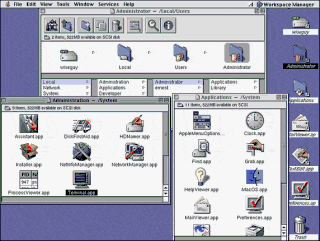
March 1999 - Apple releases Mac OS X Server, a Unix based OS with their Macintosh GUI. 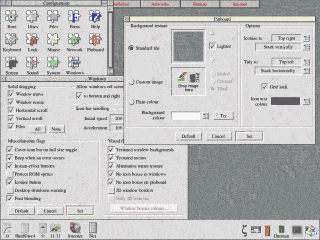
June 1999 - RISCOS Ltd releases RISC OS 4 for RiscPC, A7000 or A7000+ machines.
2000
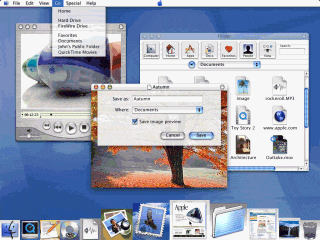
January 5, 2000: Apple announces Aqua, the new look for their upcoming MacOS X client. 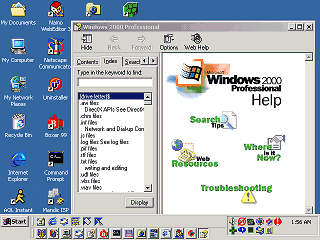
February 17, 2000: Microsoft Windows 2000 (AKA Windows NT 5) becomes available in stores.
Features: The Internet Explorer web browser application finally takes over the Windows NT UI.
2001
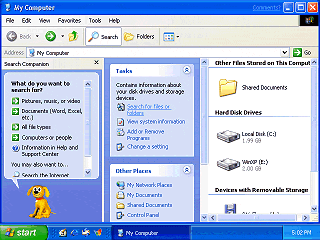
October 25, 2001: Microsoft releases Windows XP (AKA Windows NT 5.1)
Features:
Tons of eye candy.
"Product Activation" tethers XP to the existence of the Microsoft corporation.
2003
April 24, 2003: Microsoft releases Windows Server 2003 (AKA Windows NT 5.2 and for a time called "Windows.NET server")
Features:
Drops the eye candy.
Server-only release.
Notes:
I am limiting this timeline to systems that provide GUI services to other applications, this is why I am not including individual graphical DOS apps or older graphical programs such as Sketchpad .I am also not listing each version of a GUI system unless a significant change has occurred in it. MacOS has kept the basic user interface since Version 1 and is therefore only mentioned a couple of times. Microsoft, on the other hand thinks it is fun to make users learn a completely new interface every few years, so each of the Windows interfaces is listed. (Except for Windows ME which looked just like Windows 98 and 2000).
Issues:
X could just about have it’s own history page. There is no way I can list all of the different appearances of X here so I am just mentioning it’s creation. The picture is much more recent and not of the original X.
The picture of NextStep is of a later version.
The picture of PC-Geos is from Geos Ensemble 2.X with the presentation manager look.
The picture of BeOS is from a later version.
The color Mac screen shot is of MacOS 7.5.5, although these machines shipped with earlier versions.
I have insufficient information about the history of Tandy Deskmate and the Apollo workstation to place them on this timeline。
相关视频
相关阅读 Windows错误代码大全 Windows错误代码查询激活windows有什么用Mac QQ和Windows QQ聊天记录怎么合并 Mac QQ和Windows QQ聊天记录Windows 10自动更新怎么关闭 如何关闭Windows 10自动更新windows 10 rs4快速预览版17017下载错误问题Win10秋季创意者更新16291更新了什么 win10 16291更新内容windows10秋季创意者更新时间 windows10秋季创意者更新内容kb3150513补丁更新了什么 Windows 10补丁kb3150513是什么
- 文章评论
-
热门文章
 携号转网什么时候实行
携号转网什么时候实行 谷歌浏览器“Adobe Fl
谷歌浏览器“Adobe Fl 2015双11怎么抢红包_2
2015双11怎么抢红包_2 odysseusota4win图文教
odysseusota4win图文教
最新文章
 2022蚂蚁庄园6月22日今
2022蚂蚁庄园6月22日今 2022蚂蚁庄园6月21日今
2022蚂蚁庄园6月21日今
2022蚂蚁庄园6月20日今日答案 度量衡是我国2022蚂蚁庄园6月17日今日答案 夏季甜品烧仙2022蚂蚁庄园6月16日今日答案 为了减肥每天2022蚂蚁庄园6月15日今日答案 卫生纸和面巾
人气排行 B站答题答案大全 哔哩哔哩答题答案2019弹幕ipad3和ipad2的8大区别nfc功能是什么 nfc怎么用 NFC功能的手机有哪全国青少年禁毒知识竞赛在线答题 全国青少年bd版是什么意思?bd版和dvd版哪个好?手机cpu天梯图2020最新版11月 手机cpu性能天BD职位是什么?BD职业解析!硬盘划分主分区、扩展分区、逻辑分区、活动















查看所有0条评论>>